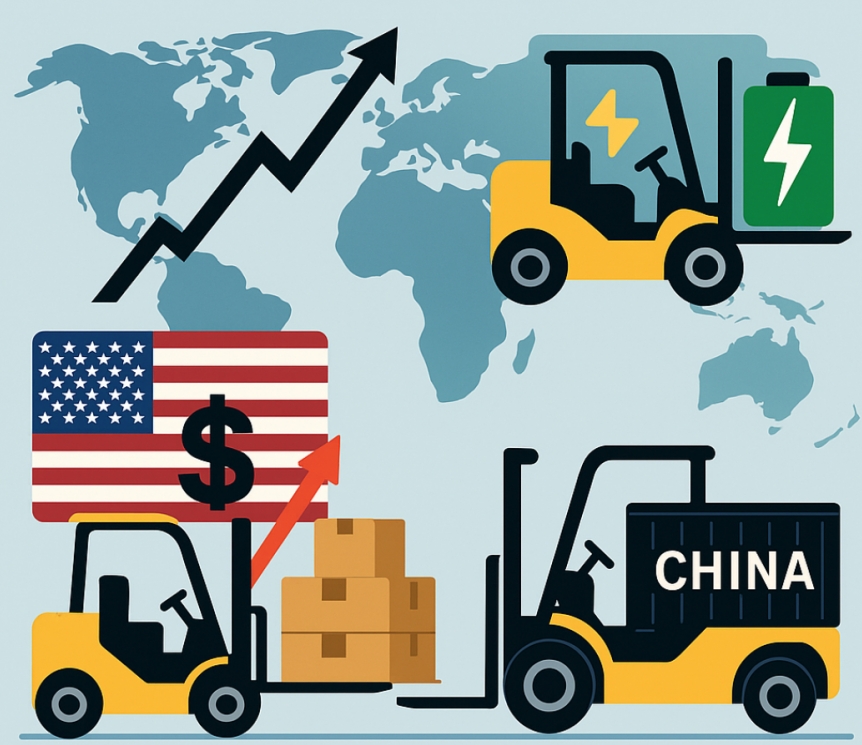Blog
Forklift Industry 2025: Electric Shift

The global forklift industry is undergoing a strategic repositioning in 2025, shaped by three powerful forces: uneven demand recovery, accelerated electrification, and significant trade policy disruptions. Regional markets show divergent trajectories while manufacturers adapt their strategies accordingly.
Regional Demand Divergence
The post-2024 inventory correction has created a fragmented global market. North America and South Korea face downward revisions, while Europe (excluding certain troubled markets), Japan, and Southeast Asia show relative optimism. China maintains stability with approximately 800,000 units annually, now primarily serving replacement demand.
North America’s “demand-side contraction” exemplifies this divergence. High interest rates combined with tariffs have made businesses cautious about capital expenditure. Industry data reveals North American forklift utilization rates dropped to 46.9% in early 2025, with operating hours declining 12.6% month-over-month.
Trade Policy Reshapes Supply Chains
The U.S. tariff policy represents a significant market disruptor. Since Spring 2025, general import tariffs supplemented by country/category-specific additions have created complex cost structures. Certain Chinese forklifts now face up to 25% additional tariffs, eroding traditional price advantages and altering procurement patterns.
The “negotiate-while-imposing” approach has created uncertainty, directly impacting supply chain pricing and cross-border inventory strategies. Summer 2025 saw extended “tariff truce periods” through multilateral negotiations, aiming to avoid dramatic cost increases before peak retail seasons.
Electrification Accelerates Amid Regional Variation
Europe’s decarbonization drive and industrial policy are pushing electric forklift adoption to new heights. Under initiatives like the “Green Industrial Plan,” electric forklift share is advancing from approximately 40% toward 60% penetration. Chinese manufacturers, particularly those with expertise in LFP (lithium iron phosphate) battery technology and system integration, are gaining traction with competitive pricing and safety advantages.
BYD exemplifies this trend with its Blade Battery technology, known for LFP chemistry, structural safety, and fast-charging capabilities. The company has announced next-generation batteries for 2025, targeting improved energy density and safety for both automotive and industrial applications.
Demand structures vary significantly by region. Japan’s semiconductor and electric vehicle investments are driving preference for automated and unmanned handling solutions. Southeast Asia’s e-commerce boom and infrastructure development are creating stronger demand for heavy-duty and warehouse models.
Corporate Strategies: Adaptation and Resilience
Leading manufacturers’ performance echoes these macro trends. Germany’s KION Group reported strong first-half 2025 results with order intake rising to €6.206 billion, supported by both new equipment and service segments. CEO Rob Smith noted “record orders for supply chain solutions in Q2,” emphasizing the company’s focus on “flexible, resilient, and intelligent” solutions to future-proof customer operations.
Toyota Industries Corporation reported average order backlogs of approximately six months for its materials handling business, with weaker North American orders but improving profitability overall. This “weaker but sticky” order structure underscores the increasing importance of replacement cycles and service-based revenue streams.
The Service & Aftermarket Opportunity
The service and aftermarket segment has emerged as a key growth area. Equipment delivered during the concentrated deployment period of the past 2-3 years is now entering maintenance and component replacement cycles. Simultaneously, digital remote services, predictive maintenance, and battery health management functionalities are increasing per-unit lifecycle value. KION’s disclosure of “significant growth in service business” during first-half 2025 exemplifies this trend.
Strategic Responses to Trade Policies
The tariff-induced industry reshuffle is prompting strategic realignments. The U.S. tariff implementation in April 2025 initially suppressed shipments followed by a rebound, creating a “transition period shipment rush” pattern. Class 1/4/5 (electric rider/internal combustion) models faced more significant impact, while Class 2 (narrow aisle) faced greater endogenous competition pressure. Class 3.1 (some electric warehouse trucks) maintained stronger positioning due to price-performance advantages.
Chinese manufacturers like Anhui Heli and Hangcha Group, with relatively low direct U.S. export exposure and strategic inventory management, experienced limited short-term impact. Long-term, investment focus is shifting toward Europe and Southeast Asia, establishing local production and service networks to mitigate trade barrier and exchange rate risks.
Technology Differentiation: The Battery Frontier
Battery systems remain the core differentiator in product competitiveness. BYD’s LFP Blade Battery technology, with its structural safety, cycle life, and fast-charging capabilities, suits multi-shift operations and high-frequency charging warehouse scenarios. For customers considering the transition from internal combustion to electric, the combination of thermal management, BMS algorithms, and overall energy consumption optimization will determine the “equivalent ownership cost” tipping point.
Leading Manufacturer Profiles
Germany’s KION Group remains a EMEA leader in industrial trucks and supply chain solutions, with Linde and Still brands supporting over 1.9 million trucks in operation across 100+ countries. The company continues investing in warehouse automation, digitalization, and service enhancement.
Toyota Industries Corporation maintains its global leadership position, leveraging lean manufacturing and extensive distribution networks. Despite North American order softness and inventory adjustments, stable backlogs and supply chain integration provide resilience.
China’s BYD represents the integrated “battery-vehicle-charging” approach, while Anhui Heli and Hangcha Group pursue “full product spectrum + regional expansion” strategies, extending their value proposition through automation, software, and services.
2026 Outlook: Structural Evolution Continues
Looking toward 2026, the industry’s core challenges remain the pace of demand recovery and the interplay between policy, currency, and cost factors. Moderate interest rate reductions in North America could stimulate capital expenditure and replacement demand. Europe should continue benefiting from green regulations, energy transition, and automation orders. Southeast Asia’s e-commerce growth and manufacturing migration will sustain demand for both warehouse and heavy-duty equipment.
If tariff truces can be maintained, channel inventory management and promotional activities will benefit from more predictable windows. OEMs and dealers will continue optimizing inventory turnover and pricing strategies accordingly.
This ongoing “strategic repositioning” represents not merely cyclical recovery but structural evolution built on technological change, policy environment shifts, and regional rebalancing. Electrification continues but at varying paces, service and aftermarket become profit anchors, and global manufacturers deepen differentiation through localization and automation. For customers, comprehensive total cost of ownership analysis, full-cycle planning for battery and charging infrastructure, and procurement strategies adaptable to multi-tariff regimes have become the three critical decision dimensions for 2025-2026.
Read more: Explore Yuweida’s range of electric forklifts and warehouse solutions designed for modern material handling challenges.

